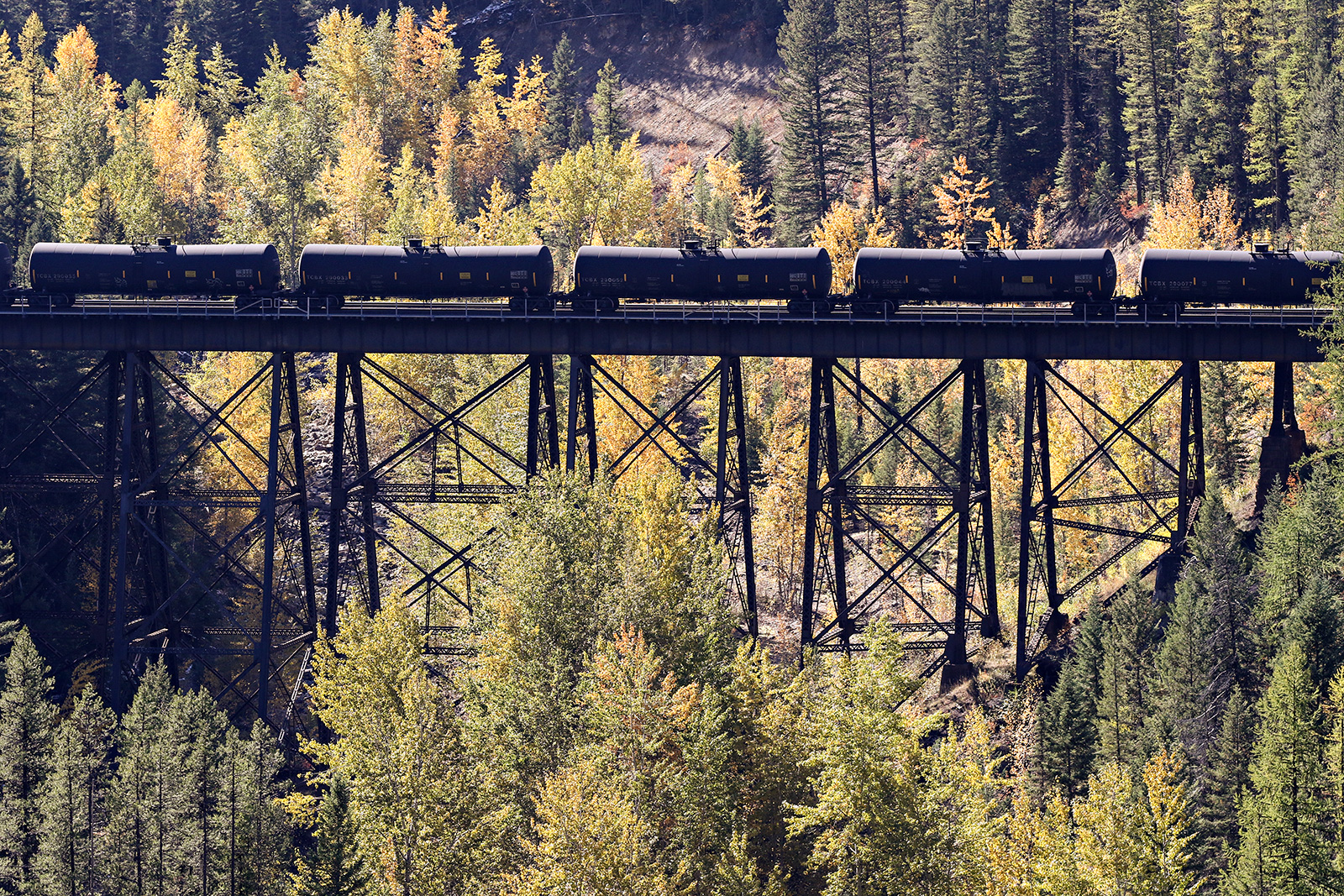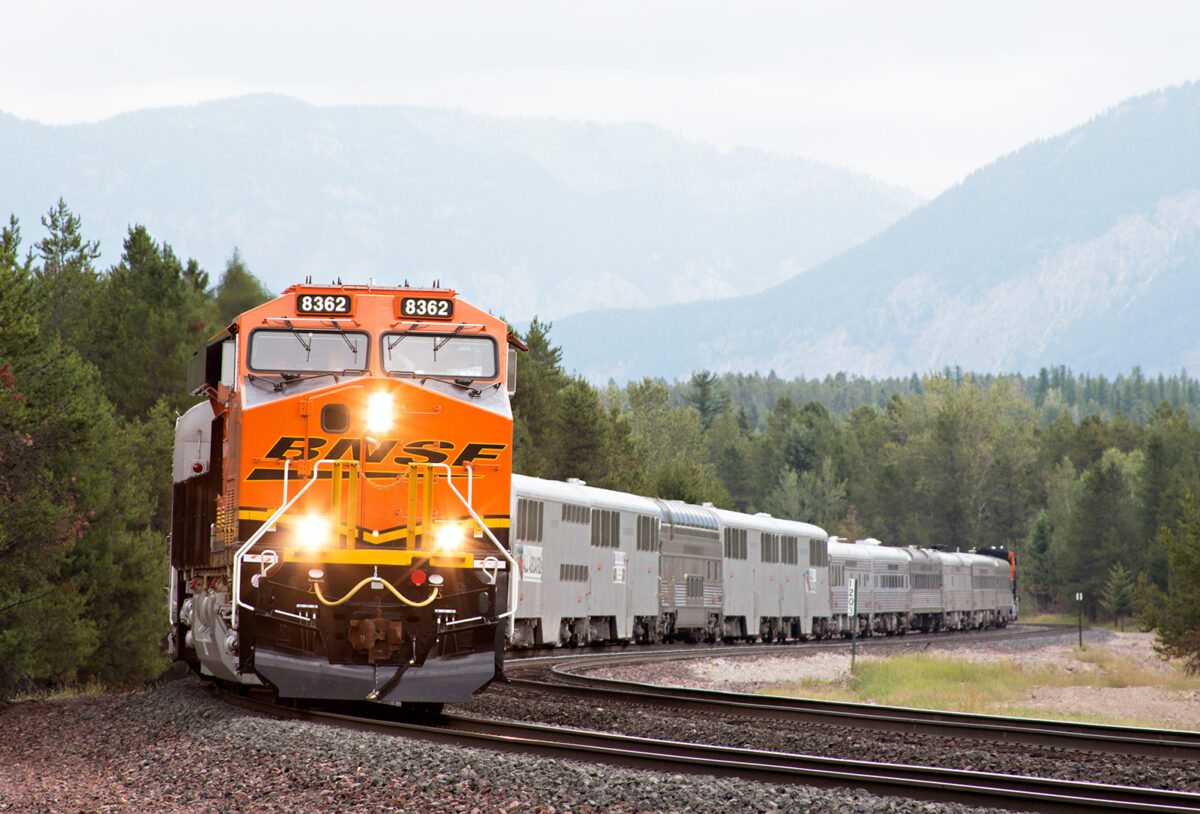Conservation Groups Sue Railway Over Grizzly Deaths
Three grizzly bear mortalities occurred in September on BNSF Railway tracks near Glacier National Park, where the company continues to operate without an incidental take permit for the endangered species
By Tristan Scott
Wildlife advocacy groups on Thursday filed a lawsuit accusing BNSF Railway Company of violating the Endangered Species Act by authorizing freight train operations that have killed dozens of grizzly bears in northwest Montana, including three recent collisions involving bears near Glacier National Park, one of which was collared for research purposes.
According to the Dec. 14 lawsuit filed in U.S. District Court in Missoula, the three train-caused grizzly bear deaths that occurred in September, which were first reported by the Beacon, are just the latest example of a problem stretching back decades. Since 2008, wildlife managers have tallied 63 grizzly bear mortalities resulting from train collisions in the Northern Continental Divide Ecosystem (NCDE), according to the lawsuit, while at least three other grizzlies were killed in trail collisions in the remote Cabinet-Yaak recovery zone between 2001 and 2008.
Although BNSF has long acknowledged that its freight trains along a 206-mile stretch of tracks between Shelby and Trego pose an inherent threat to the grizzlies living nearby, it continues to run trains through two designated grizzly bear recovery zones without an incidental take permit for the threatened species, the lawsuit states, and despite not having formalized a long overdue habitat conservation plan that includes millions of dollars in funding to help bear managers mitigate grizzly mortalities in the region.
In 2004, 2020 and again in 2023 following the most recent bear mortalities, BNSF Railway Company applied to the U.S. Fish and Wildlife Service (FWS) for an Incidental Take Permit (ITP) and formally submitted a Habitat Conservation Plan (HCP) outlining measures it would take to reduce train-caused grizzly mortalities in the region.
“None of these habitat conservation plans nor incidental take permits has been finalized,” the lawsuit states.

According to an email from a BNSF spokesperson, Lena Kent, the delays are a consequence of the company and FWS “working collaboratively to respond to and address public comments and to consider and incorporate data and information published by FWS and the NCDE Grizzly Bear Monitoring Team after the original BNSF application was submitted.”
Although Kent stated in an email Thursday that BNSF declined to comment on the litigation, she explained that “hundreds of comments were received and the final HCP has been submitted to the U.S. Fish and Wildlife Service to be reviewed before it is published.”
“The HCP memorializes many of the steps BNSF has already been taking to reduce grizzly bear deaths, she said.
Those steps include: Removal of spilled or leaked grain and carrion from track structures; reducing and removing vegetation that might attract grizzly bears; funding for additional grizzly bear managers for Montana Fish Wildlife and Parks and the Blackfeet Nation; funding for radio collars, bear-proof garbage bins and electric fencing; and funding for grizzly bear awareness programs.
“BNSF’s goal is to reduce grizzly bear mortality and maintain compliance with the Endangered Species Act,” Kent stated.
FWS spokesperson Joe Szuszwalak said Thursday that the federal agency “respectfully declines to comment on the litigation,” but he confirmed that agency officials on Nov. 11 received a final Habitat Conservation Plan from BNSF Railway and “are currently assessing the HCP and anticipate a final decision in early 2024.”

Current and former wildlife managers have applauded BNSF’s efforts to clean up bear attractants from its railway in recent years, but they’ve also raised concerns about a process that’s been beset with delays for two decades. Some state and tribal wildlife officials have expressed skepticism about the company’s explanation for those delays, as well as its failure to formalize the conservation plan, prompting speculation that the delays are calculated. In February, FWS announced it is considering whether grizzly bears in the NCDE are sufficiently recovered to trigger removal from protections under the Endangered Species Act.
“I have essentially been involved in this thing for 20 years and my opinion is that BNSF is stalling until bears get delisted, in which case they wouldn’t need an incidental take permit,” Tim Manley, a retired grizzly bear biologist who spent 37 years as Montana Fish, Wildlife and Parks’ grizzly bear management specialist in northwest Montana, said. “In 2021, the final draft was put together and sent out for public comment. It still has not been signed off on by BNSF and here we’re going on three years.”
Kent, the BNSF spokesperson, insists that the delays are not intentional.
“This process, while comprehensive, has taken considerable time to accomplish,” according to Kent. “BNSF has never sought to delay the final HCP for any reason, including the possible delisting of the grizzly bear. Delisting was discussed in the Draft HCP published in 2021, so this is not a new topic.”
Pete Frost, an attorney with the Western Environmental Law Center who filed the lawsuit on behalf of WildEarth Guardians and the Western Watersheds Project, also threatened to sue the railway company in 2019 after nine bears were reportedly killed due to train strikes in the NCDE. However, the coalition of wildlife advocacy groups eventually backed away from the lawsuit, in part because Frost says the burden to prove the “prospect of future take” was too high. Frost said he hadn’t heard of any other grizzly bear mortalities on BNSF tracks until reading the Beacon’s Oct. 4 report.

According to the lawsuit, BNSF has expanded its railway operations in the NCDE and Cabinet-Yaak grizzly bear recovery zones by taking over Montana Rail Link (MRL) operations, and “it is reasonably likely that trains operating on the railway between Shelby, Montana, and Sandpoint, Idaho, will continue to strike grizzly bears” in both the Cabinet-Yaak and NCDE recovery zones.
Although BNSF says its recently submitted HCP will address those concerns, Frost countered that “the company has been playing that tune for 20 years.”
“Meantime the only constant is its trains continue to kill grizzlies,” Frost said.
According to FWS, it’s been waiting on BNSF Railway to finalize the habitat conservation plan since the closing of a public comment period in early 2021, when the federal agency announced an incidental take permit application and associated habitat conservation plan from BNSF.
The draft plan pledges more than $2 million to fund the salaries and operational costs of two new Montana Fish, Wildlife and Parks (FWP) grizzly bear technicians and a third grizzly bear technician for the Blackfeet Nation, as well as related grizzly bear conservation projects and programs, including waste management, electric fencing, remote cameras, radio collars, hunter education, and a new grizzly bear database over the seven-year life of the plan.
Under the plan, BNSF would also establish a reserve account of $1 million to fund programs and projects designed by the HCP technical committee to respond to new data discoveries, the identification of new factors contributing to train strikes, “or the arrival of new challenges and solutions as grizzly bear populations expand.” Developed over the course of nearly 20 years and based on extensive consultation with bear experts from FWS, FWP, the Blackfeet Nation, and Glacier National Park, the plan and the pot of BNSF money would be administered by the Montana Outdoor Legacy Foundation, a nonprofit organization that works closely with FWP on conservation efforts throughout the state.
In exchange, FWS would issue BNSF an ITP under Section 10 of the Endangered Species Act (ESA), an exception that allows the federal wildlife management agency to issue permits for the “incidental take” of grizzly bears “if such taking is incidental to, and not the purpose of, the carrying out of an otherwise lawful activity.”
If issued, the permit would authorize the take of approximately 18 grizzly bears incidental to BNSF Railway operations during a seven-year period on the stretch of railway between Shelby and Trego.